Common Quince, Smyrna quince
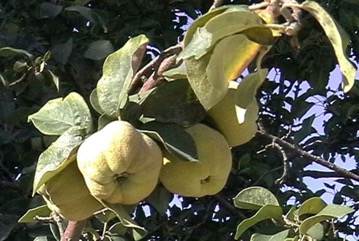
It grows in Mediterranean and temperate climates. It can grow in the highlands in the tropics. It is native to C. and S.W. Asia. It often grows on limestone. The tree is frost hardy. It will grow in many types of soil. It does best with a pH of 6-7. It can grow in a hot dry climate. A quince needs 100-400 hours of chilling. It suits hardiness zones 4-9. Hobart Botanical Gardens. Arboretum Tasmania.
Also known as:
Amritphala, Ayva, Bam-tsuntu, Bamsutu, Bihi, Coines, Coing, Cotogna, Cydonian apple, Duna, Ftoi, utui, Ftoin, Kaontsy, Marmelo, Marumero, Melo cotogno, Membrillo, Mocqua, Mu gua, Navadna kutina, Quitte, Shimaimathala, Simadanimma, Simedalimbe, Voamerika, Wen po
Synonyms
- Cydonia vulgaris Pers.
- Pyrus cydonia L.
Edible Portion
- Fruit, Seeds - drink, Flowers, Leaves
Where does Common Quince grow?
Found in: Africa, Albania, Armenia, Asia, Australia, Azerbaijan, Brazil, Caucasus, Central Asia, Chile, China, East Africa, Europe, Georgia, Greece, India, Indochina, Iran, Iraq, Italy, Lithuania, Macedonia, Madagascar, Mediterranean, Mexico, Moldova, North Africa, North America, Pakistan, Portugal, SE Asia, Serbia, Slovenia, South Africa, Southern Africa, South America, Sri Lanka, Tajikistan, Tasmania, Turkey, Turkmenistan, Uruguay, United States, Uzbekistan, Vietnam, Russian Federation - Ciscaucasia, Dagestan, Zimbabwe
Growing Common Quince, Smyrna quince
Cultivation: Plants can be grown easily from cuttings of 2 or 3 year old wood. They can also be grown from seed or by layering. Fresh seed can be used. If seed have been stored they will need 2-4 weeks of gentle warmth followed by 4 months of cold treatment before sowing. They can be grafted.
Edible Uses: The fruit are usually cooked. They are good for jelly and preserves. They are made into pies, candy and jams. The seeds are dried and crushed then simmered for 5 minutes in water and sweetened to taste to make a drink. The seeds also yield a gum used as a stabiliser for ice cream. The leaves are used as wrappings for dolmas. The leaves are used for sarma in Turkey. They are rolled around a filling of rice or minced meat. The flowers can be eaten.
Production: Trees are slow growing. Trees bear in 3-4 years. Trees can live for 50 years.
Nutrition Info
per 100g edible portion| Edible Part | Energy (kcal) | Protein (g) | Iron (mg) | Vitamin A (ug) | Vitamin c (mg) | Zinc (mg) | % Water |
|---|---|---|---|---|---|---|---|
| Fruit | 25 | 0.3 | 0.3 | 4 | 15 | 0.04 | 84.2 |
Common Quince, Smyrna quince Photos

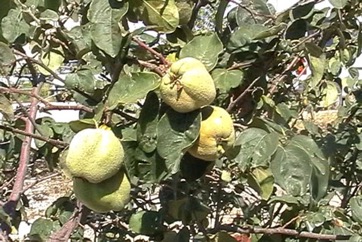
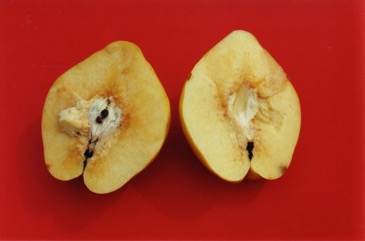
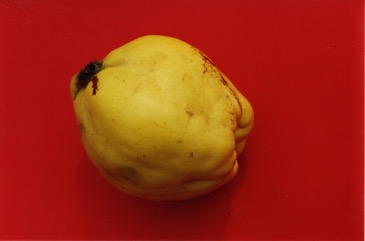
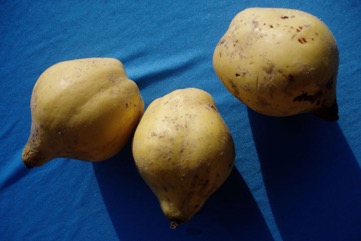
References
Ambasta, S.P. (Ed.), 2000, The Useful Plants of India. CSIR India. p 154
Beckstrom-Sternberg, Stephen M., and James A. Duke. "The Foodplant Database." http://probe.nalusda.gov:8300/cgi-bin/browse/foodplantdb.(ACEDB version 4.0 - data version July 1994)
Bianchini, F., Corbetta, F., and Pistoia, M., 1975, Fruits of the Earth. Cassell. p 134
Bodkin, F., 1991, Encyclopedia Botanica. Cornstalk publishing, p 312
Bodkin, F., 1991, Encyclopedia Botanica. Cornstalk publishing, p 312 (As Cydonia vulgaris) and p 858 (As Pyrus cydonia)
Bremness, L., 1994, Herbs. Collins Eyewitness Handbooks. Harper Collins. p 51
Brickell, C. (Ed.), 1999, The Royal Horticultural Society A-Z Encyclopedia of Garden Plants. Convent Garden Books. p 329
Brouk, B., 1975, Plants Consumed by Man. Academic Press, London. p 197
Bussman, R. W., et al, 2016, A comparative ethnobotany of Khevsureti, Samtskhe-Javakheti, Tusheti, Svaneti, and Racha-Lechkhumi, Republic of Georgia (Sakartvelo), Caucasus. Journal of Ethnobiology and Ethnomedicine.
Bussman, R. W. et al, 2017, Ethnobotany of Samtskhe-Javakheti, Sakartvelo (Republic of Georgia), Caucasus. Indian Journal of Traditional Knowledge Vol. 16(1) pp 7-24
Cheifetz, A., (ed), 1999, 500 popular vegetables, herbs, fruits and nuts for Australian Gardeners. Random House p 187
Coombes, A.J., 2000, Trees. Dorling Kindersley Handbooks. p 244
Cruz, I. M., et al, 2015, Edible fruits and seeds in the State of Mexico. Revista Mexicana de Ciencias Agricolas. Vol. 6. Num. 2 pp 331-346
Cundall, P., (ed.), 2004, Gardening Australia: flora: the gardener's bible. ABC Books. p 451
Dobriyal, M. J. R. & Dobriyal, R., 2014, Non Wood Forest Produce an Option for Ethnic Food and Nutritional Security in India. Int. J. of Usuf. Mngt. 15(1):17-37
Dogan, Y., et al, 2015, Of the importance of a leaf: the ethnobotany of sarma in Turkey and the Balkans. Journal of Ethnobiology and Ethnomedicine, 11:56
Etherington, K., & Imwold, D., (Eds), 2001, Botanica's Trees & Shrubs. The illustrated A-Z of over 8500 trees and shrubs. Random House, Australia. p 248
Facciola, S., 1998, Cornucopia 2: a Source Book of Edible Plants. Kampong Publications, p 198
Flora of China. www.eFloras.org Volume 9
Flowerdew, B., 2000, Complete Fruit Book. Kyle Cathie Ltd., London. p 32
Flowerdew, B., 2000, Complete Fruit Book. Kyle Cathie Ltd., London. p 32 (As Cydonia vulgaris)
Gard. dict. ed. 8: Cydonia no. 1. 1768
Glowinski, L., 1999, The Complete Book of Fruit Growing in Australia. Lothian. p 39
Gouldstone, S., 1983, Growing your own Food-bearing Plants in Australia. Macmillan p 126
Hedrick, U.P., 1919, (Ed.), Sturtevant's edible plants of the world. p 538 (As Pyrus cydonia)
Hibbert, M., 2002, The Aussie Plant Finder 2002, Florilegium. p 79
Hu, Shiu-ying, 2005, Food Plants of China. The Chinese University Press. p 431
Huxley, A. (Ed.), 1977, The Encyclopedia of the Plant Kingdom. Chartweil Books. p 59 (As Cydonia vulgaris)
Jardin, C., 1970, List of Foods Used In Africa, FAO Nutrition Information Document Series No 2.p 131
John, L., & Stevenson, V., 1979, The Complete Book of Fruit. Angus & Robertson p 243
Kargioglu, M., et al, 2008, An Ethnobotanical Survey of Inner-West Anatolia, Turkey. Human Ecology 36:763-777
Khan, D. & Shaukat, S.S., 2006, The Fruits of Pakistan: Diversity, Distribution, Trends of Production and Use. Int. J. Biol. Biotech., 3(3):463-499
Kiple, K.F. & Ornelas, K.C., (eds), 2000, The Cambridge World History of Food. CUP p 1841
Kizilarslan, C. & Ozhatay, N., 2012, An ethnobotanical study of the useful and edible plants of İzmit. Marmara Pharmaceutical Journal 16: 134-140, 2012.
Lazarides, M. & Hince, B., 1993, Handbook of Economic Plants of Australia, CSIRO. p 71
Lyle, S., 2006, Discovering fruit and nuts. Land Links. p 170
Macmillan, H.F. (Revised Barlow, H.S., et al) 1991, Tropical Planting and Gardening. Sixth edition. Malayan Nature Society. Kuala Lumpur. p 314
Martin, F. W., et al, 1987, Perennial Edible Fruits of the Tropics. USDA Handbook 642 p 53
Pham-Hoang Ho, 1999, An Illustrated Flora of Vietnam. Nha Xuat Ban Tre. p 780
Pieroni, A., 1999, Gathered wild food plants in the Upper Valley of the Serchio River (Garfagnana), Central Italy. Economic Botany 53(3) pp 327-341
Pieroni, A., et al, 2005, Food for two seasons: Culinary uses of non-cultivated local vegetables and mushrooms in a south Italian village. International Journal of Food Sciences and Nutrition, 56(4): 245-272
Pieroni, A., 2008, Local plant resources in the ethnobotany of Theth, a village in the Northern Albanian Alps. Genet Resour Crop Evol (2008) 55:1197–1214
Pieroni, A., 2017, Traditional uses of wild food plants, medicinal plants, and domestic remedies in Albanian, Aromanian and Macedonian villages in South-Eastern Albania. Journal of Herbal Medicine Volume 9, September 2017, Pages 81-90
Plants for a Future database, The Field, Penpol, Lostwithiel, Cornwall, PL22 0NG, UK. http://www.scs.leeds.ac.uk/pfaf/
Polat, R., et al, 2017, Survey of wild food plants for human consumption in Bingol, (Turkey). Indian Journal of Traditional Knowledge. Vol. 16(3) July 2017, pp. 378-384
Postman, J. D., et al, 2012, Recent NPGS Coordinated Expeditions in the Trans-Caucasus Region to Collect Wild Relatives of Temperate Fruit and Nut Crops. In Acta Horticulturae Number 948 p 191-198
Ruiters-Welcome, A. K., 2019, Food plants of southern Africa. Ph.D. thesis. Univ. of Johannesburg p 94
Segura, S., et al, 2018, The edible fruit species in Mexico. Genet Resour Crop Evol (2018) 65:1767–1793
Smith, K., 1998. Growing Uncommon Fruits and Vegetables. New Holland. p 150
Solomon, C., 2001, Encyclopedia of Asian Food. New Holland. p 303 (As Cydonia vulgaris)
Sp. pl. 1:480. 1753 (As Pyrus cydonia)
USDA, ARS, National Genetic Resources Program. Germplasm Resources Information Network - (GRIN). [Online Database] National Germplasm Resources Laboratory, Beltsville, Maryland. Available: www.ars-grin.gov/cgi-bin/npgs/html/econ.pl (10 April 2000)
van Wyk, B., 2005, Food Plants of the World. An illustrated guide. Timber press. p 168
World Checklist of Useful Plant Species 2020. Royal Botanic Gardens, Kew
Young, J., (Ed.), 2001, Botanica's Pocket Trees and Shrubs. Random House. p 302